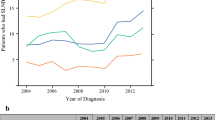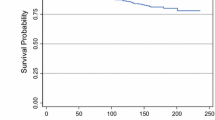Abstract
Background:Results from randomized trials indicate a 5.4% survival advantage associated with axillary dissection. To gain insight on survival outcomes when less than an axillary dissection is performed, we performed a retrospective analysis to determine survival outcome for node-negative and node-positive breast cancer patients when a variable number of nodes were excised.
Methods:The data analyzed in this paper are from the Surveillance, Epidemiology, and End Results (SEER) database, from which 72,102 patients were selected whose breast cancer had been diagnosed in 1988 or later and who were aged 40–79 years at diagnosis, had a single primary lesion, and had 0 to 3 positive lymph nodes. Cases were separated into age groups (40 to 49 and 50 to 79 years), and node-negative cases were separated from those with one to three positive nodes.
Results:This analysis indicates that even when all regional lymph nodes are pathologically negative, the number of nodes removed is associated with survival. In the group of breast cancer patients who had one to three pathologically positive nodes, as with the node-negative group, the higher the number of nodes removed, the greater the survival. The hazard rate for death in the node-negative group was roughly 5% less for each additional five nodes removed. For the node-positive group, the hazard rate for death was between 8% and 9% less for each additional five nodes removed.
Conclusions:This retrospective study supports the notion that removal of regional nodes, even when such nodes are interpreted as pathologically negative, is important for the long-term survival of breast cancer patients.
Similar content being viewed by others

REFERENCES
Fisher B, Redmond C, Fisher ER, et al. Ten-year results of a randomized clinical trial comparing radical mastectomy and total mastectomy with or without radiation. N Engl J Med 1985; 312: 674–81.
Morrow M. Is axillary dissection necessary after positive sentinel node biopsy? Yes! Ann Surg Oncol 2001; 8 (Suppl): 74S–76S.
Harris JR, Osteen RT. Patients with early breast cancer benefit from effective axillary treatment. Breast Cancer Res Treat 1985; 5: 17–21.
Johansen H, Kaae S, Schiodt T. Simple mastectomy with postoperative irradiation versus extended radical mastectomy in breast cancer: a twenty-five-year follow-up of a randomized trial. Acta Oncol 1990; 29: 709–15.
Langlands AO, Prescott RJ, Hamilton T. A clinical trial in the management of operable cancer of the breast. Br J Surg 1980; 67: 170–4.
Atkins H, Hayward JL, Klugman DJ, Wayte AB. Treatment of early breast cancer: a report after ten years of a clinical trial. BMJ 1972; 2: 423–9.
Hayward JI. The Guy’s Hospital trials on breast conservation. In: Harris JR, Hellman S, Silen W, eds. Conservative Management of Breast Cancer: New Surgical and Radiotherapeutic Techniques. Philadelphia: JB Lippincott, 1983: 77–90.
Cabanes PA, Salmon RJ, Vilcoq JR, et al. Value of axillary dissection in addition to lumpectomy and radiotherapy in early breast cancer. The Breast Carcinoma Collaborative Group of the Institut Curie. Lancet 1992; 339: 1245–8.
Orr RK. The impact of prophylactic axillary node dissection on breast cancer survival: a Bayesian meta-analysis. Ann Surg Oncol 1999; 6: 109–16.
Polychemotherapy for early breast cancer: an overview of the randomised trials. Early Breast Cancer Trialists’ Collaborative Group. Lancet 1998;352:930–42.
Bland KI, Scott-Conner CE, Menck H, Winchester DP. Axillary dissection in breast-conserving surgery for stage I and II breast cancer: a National Cancer Data Base study of patterns of omission and implications for survival. J Am Coll Surg 1999; 188: 586–95;discussion, 595–6.
Fisher B, Slack NH. Number of lymph nodes examined and the prognosis of breast carcinoma. Surg Gynecol Obstet 1970; 131: 79–88.
van der Wal B, Butzelaar RM, van der Meij S, Boermeester MA. Axillary lymph node ratio and total number of removed lymph nodes: predictors of survival in stage I and II breast cancer. Eur J Surg Oncol 2002; 28: 481–9.
Weir L, Speers C, D’yachkova Y, Olivotto IA. Prognostic significance of the number of axillary lymph nodes removed in patients with node-negative breast cancer. J Clin Oncol 2002; 20: 1793–9.
Sosa JA, Diener-West M, Gusev Y, et al. Association between extent of axillary lymph node dissection and survival in patients with stage I breast cancer. Ann Surg Oncol 1998; 5: 140–9.
Mathiesen O, Carl J, Bonderup O, Panduro J. Axillary sampling and the risk of erroneous staging of breast cancer: an analysis of 960 consecutive patients. Acta Oncol 1990; 29: 721–5.
Axelsson CK, Mouridsen HT, Zedeler K. Axillary dissection of level I and II lymph nodes is important in breast cancer classification. The Danish Breast Cancer Cooperative Group (DBCG). Eur J Cancer 1992; 28A: 1415–8.
Moorman PG, Hamza A, Marks JR, Olson JA. Prognostic significance of the number of lymph nodes examined in patients with lymph node-negative breast carcinoma. Cancer 2001; 91: 2258–62.
Camp RL, Rimm EB, Rimm DL. A high number of tumor free axillary lymph nodes from patients with lymph node negative breast carcinoma is associated with poor outcome. Cancer 2000; 88: 108–13.
Tepper JE, O’Connell MJ, Niedzwiecki D, et al. Impact of number of nodes retrieved on outcome in patients with rectal cancer. J Clin Oncol 2001; 19: 157–63.
Chan AD, Essner R, Wanek LA, Morton DL. Judging the therapeutic value of lymph node dissections for melanoma. J Am Coll Surg 2000; 191: 16–22;discussion, 22–3.
Saphir O, Amromin G. Obscure axillary lymph-node metastasis in carcinoma of the breast. Cancer 1948; 1: 238–241.
Weaver DL, Krag DN, Ashikaga T, Harlow SP, O’Connell M. Pathologic analysis of sentinel and nonsentinel lymph nodes in breast carcinoma: a multicenter study. Cancer 2000; 88: 1099–107.
Bostick PJ, Huynh KT, Sarantou T, et al. Detection of metastases in sentinel lymph nodes of breast cancer patients by multiple-marker RT-PCR. Int J Cancer 1998; 79: 645–51.
Heller R, Becker J, Wasselle J, et al. Detection of submicroscopic lymph node metastases in patients with melanoma. Arch Surg 1991; 126: 1455–9;discussion, 1459–60.
Osborne MP, Ormiston N, Harmer CL, McKinna JA, Baker J, Greening WP. Breast conservation in the treatment of early breast cancer: a 20-year follow-up. Cancer 1984; 53: 349–55.
Author information
Authors and Affiliations
Corresponding author
Additional information
The authors both contributed to conception and design; acquisition of a substantial portion of data; analysis and interpretation of data; drafting of the manuscript; and critical revision of the manuscript for important intellectual content and statistical expertise. Each author declares no competing interests.
Rights and permissions
About this article
Cite this article
Krag, D.N., Single, R.M. Breast Cancer Survival According to Number of Nodes Removed. Ann Surg Oncol 10, 1152–1159 (2003). https://doi.org/10.1245/ASO.2003.03.073
Received:
Accepted:
Issue Date:
DOI: https://doi.org/10.1245/ASO.2003.03.073



